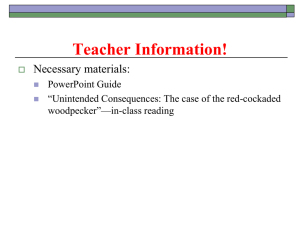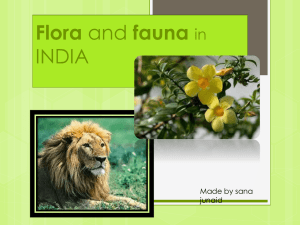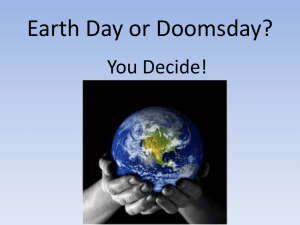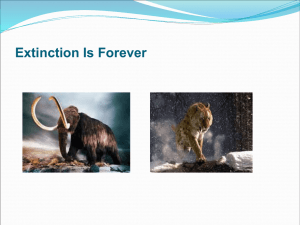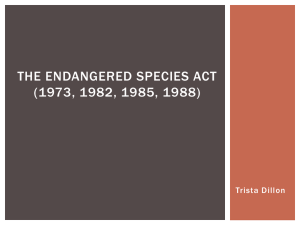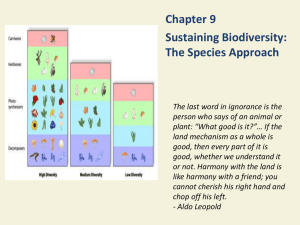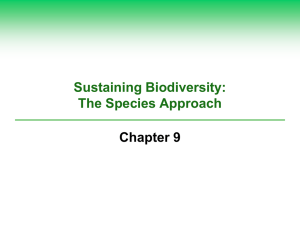Notes
advertisement
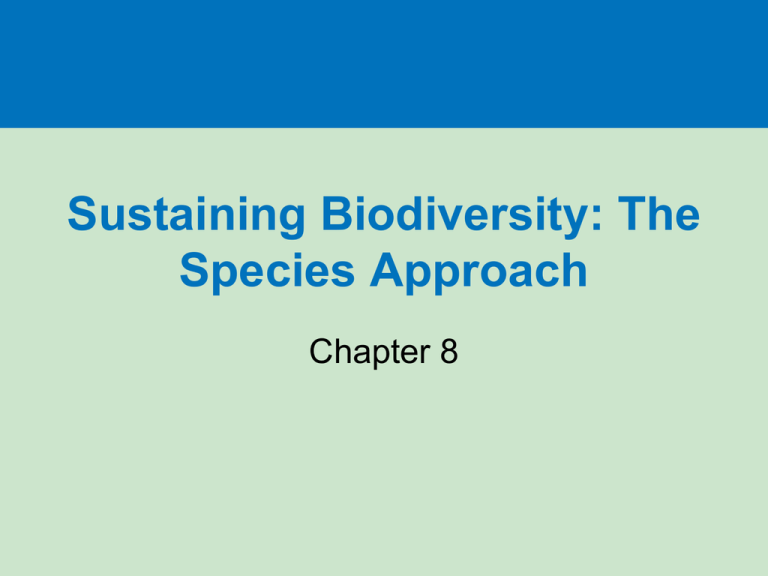
Sustaining Biodiversity: The Species Approach Chapter 8 Three big ideas • We are greatly increasing the extinction of wild species by “HIPPOCD”. • We should avoid causing the extinction of wild species because of their economic and ecological value, and because they exist. • We can save some species and protect biodiversity using your vote and your dollar! (laws/treaties, protecting wildlife sanctuaries, and use of the precautionary principle). Section 8-1 WHAT ROLE DO HUMANS PLAY IN THE EXTINCTION OF SPECIES? Some human activities are causing extinction rates to rise • Extinction is a natural process… on average species persist for 1-2 million years. • What do you suppose the rate is now? • The annual extinction rate is projected to rise to about 1% per year, mostly because of … • At a 1% extinction rate, 25% - 50% of the world’s current species could vanish by the end of this century. Characteristics that can put certain species in greater danger of extinction Percentages of various species threatened with extinction due to human activities Section 8-2 WHY SHOULD WE CARE ABOUT THE RISING RATE OF SPECIES EXTINCTION? Species are a vital part of the earth’s natural capital • Major reasons why we should work to prevent our activities from causing the extinction of other species: • They provide natural resources and natural services that help to keep us alive and support human economies. – Examples? • Also provide economic benefits – Examples? Species are a vital part of the earth’s natural capital Major reasons why we should work to prevent our activities from causing the extinction of other species: • Preserving species also provides economic benefits through wildlife/eco tourism. Species are a vital part of the earth’s natural capital • They losses are replaced VERY slowly – Est. 5–10 million years for evolution to rebuild biodiversity likely destroyed during your lifetime. • Ethics! – Many people believe that each wild species has a right to exist, regardless its usefulness to us. Section 8-3 HOW DO HUMANS ACCELERATE SPECIES EXTINCTION? Loss of habitat is the single greatest threat to species: Remember HIPPCO • HIPPCO summarizes the most important causes of extinction from human activities: – Habitat destruction/degradation/fragmentation. – Invasive (nonnative) species. – Population growth/increasing use of resources. – Pollution. – Overexploitation – Climate change. – Disease Loss of habitat is the single greatest threat to species: Remember HIPPCO • Scientists say that the greatest threat to wild species is habitat loss, degradation, and fragmentation. The greatest eliminators of species are, in order: – Deforestation in tropical areas. – “Loss” of coral reefs and wetlands. – Replacement of biologically diverse grasslands with monoculture crops. – Pollution of streams, lakes, and oceans. Reductions in the ranges of four species Harmful invasive species We have introduced species that can disrupt ecosystems • An estimated 7,100 species introduced into the US have caused ecological and economic harm. • CASE STUDY: The Kudzu Vine. – A deliberately introduced plant species; grows rampant in the southeastern US and is known as ‘the vine that ate the South’. – In the 1930s, this vine was imported from Japan and planted in the southeastern US in an attempt to control soil erosion. House overtaken by kudzu Zebra mussels attached to a water current meter in Lake Michigan Ways we can slow or prevent the spread of invasive species Population growth, overconsumption, pollution, and climate change can cause species extinctions • Past and projected human population growth and excessive and wasteful consumption of resources have greatly expanded the human ecological footprint, impacting other species. • Pollution also threatens some species with extinction, as has been shown by the unintended effects of certain pesticides. – Each year pesticides kill about 20% of the honeybee colonies that pollinate almost 33% of U.S. food crops, kill more than 67 million birds and 6–14 million fish each year, and threaten about 20% of the country’s endangered and threatened species. Population growth, overconsumption, pollution, and climate change can cause species extinctions – The pesticide DDT can be biomagnified about 10 million times in an estuary food chain, causing animals such as the osprey, brown pelican and bald eagles to die. • Projected climate change could help drive a quarter to half of all land animals and plants to extinction by the end of this century. http://www.pbs.org/wnet/nature/episodes/fr ogs-the-thin-green-line/video-fullepisode/4882/ Bioaccumulation and biomagnification CASE STUDY: Where Have All The Honeybees Gone? • About one-third of the U.S. food supply comes from insect-pollinated plants, and honeybees are responsible for 80% of that pollination. • A 30% - 40% drop in U.S. honeybee populations has been reported since the 1980s, due to: – – – – – Pesticide exposure. Parasitic mites - can wipe out a colony in hours. Invasion by Africanized honeybees. A virus traced to Israel, and a certain fungus. Poor nutrition because of a decrease in the natural diversity of flowers and other plants on which bees feed. CASE STUDY: Where Have All The Honeybees Gone? • In 2010, about 34% of commercial honeybee colonies in the U.S. were lost in part to colony collapse disorder (CCD), causing adult bees to mysteriously disappear. • Strategies to help honeybee populations: – Beekeepers are reducing CCD by practicing stringent hygiene, improving the diets of the bees, and trying to reduce viral infections. – Cut back on use of pesticides, especially at midday when honeybees are most likely to be searching for nectar. – Make our yards and gardens into buffets for honey bees by planting native plants that they like. – Bees need places to live, so some homeowners are purchasing bee houses from their local garden centers. Male mountain gorilla Poached white rhinoceros Rising demand for bush meat threatens some African species • Indigenous people in much of West and Central Africa have sustainably hunted wildlife for bush meat, a source of food, for centuries. • In the last two decades, bush meat hunting in some areas has skyrocketed as hunters try to provide food for rapidly growing populations or to make a living by supplying restaurants with exotic meats. • Bush meat hunting has led to the local extinction of many wild animals, driven one species of colobus monkey to complete extinction, and been a factor in reducing some populations of orangutans, chimpanzees, elephants, and hippopotamuses. CASE STUDY: A Disturbing Message from the Birds • Approximately 70% of the world’s known bird species are declining in number. • The primary culprits appear to be habitat loss and fragmentation. Section 8-4 HOW CAN WE PROTECT WILD SPECIES FROM EXTINCTION? The U.S. Endangered Species Act • The ESA forbids federal agencies (except the Defense Department) to carry out, fund, or authorize projects that would jeopardize an endangered or threatened species, or destroy or modify its critical habitat. • For offenses committed on private lands, fines as high as $100,000 and 1 year in prison. • Between 1973 and 2011, the number of U.S. species on the official endangered and threatened species lists increased from 92 to more than 1,320. The U.S. Endangered Species Act • Since 1982, the ESA has been amended to give private landowners economic incentives to help save endangered species living on their lands. • Some believe that the ESA should be weakened or repealed, and others believe it should be strengthened and modified to focus on protecting ecosystems. • The ESA and international agreements have been used to identify and protect endangered and threatened marine species such as seals, sea lions, sea turtles, and whales. CASE STUDY: Protecting Endangered Sea Turtles • Six of the world’s seven sea turtle species are critically endangered or endangered. What are the two major threats to sea turtles? Endangered leatherback sea turtle tangled in a fishing net CASE STUDY: Protecting Whales: A Success Story . . . So Far • Easier to kill due to their large size and their need to come to the surface to breathe. – Whalers killed an estimated 1.5 million whales between 1925 and 1975, driving 8 of the 11 major species to commercial extinction and driving the blue whale, the world’s largest animal, to the brink of biological extinction. – The International Whaling Commission estimates some whale species are recovering, but many conservationists fear that opening the door to any commercial whaling may weaken international disapproval and legal sanctions. – Despite the ban on whaling, more than 28,000 whales were hunted and killed between 1986 and 2010, mostly by the nations of Japan, Norway, and Iceland, which have openly defied the ban. Gene banks, botanical gardens, and wildlife farms can help to protect species • Gene or seed banks preserve genetic information and endangered plant species by storing their seeds in refrigerated, low-humidity environments. • More than 100 seed banks worldwide collectively hold about 3 million samples, however: – Some species cannot be preserved in gene banks. – The banks are expensive to operate and can be destroyed by fires and other mishaps. – A new underground vault on a remote island in the Arctic will eventually contain 100 million of the world’s seeds and will not be vulnerable to power losses, fires, storms, or war. Gene banks, botanical gardens, and wildlife farms can help to protect species • The world’s 1,600 botanical gardens and arboreta contain living plants, representing almost one-third of the world’s known plant species but only about 3% of the world’s rare and threatened plant species. • Some endangered or threatened species are raised on farms for commercial sale, such as alligator farms in Florida and butterfly Papua New Guinea. Zoos and aquariums can protect some species • Zoos, aquariums, game parks, and animal research centers are being used to preserve some individuals of critically endangered animal species, with the longterm goal of reintroducing the species into protected wild habitats. • Two preserving techniques are: 1. Egg pulling, where wild eggs laid by critically endangered bird species are collected and then hatched in zoos or research centers. Zoos and aquariums can protect some species 2. Captive breeding, where some or all of the wild individuals of a critically endangered species are captured for breeding in captivity, with the aim of reintroducing the offspring into the wild. • Limited space and budgets restrict efforts to maintain breeding populations of endangered animal species that are large enough to avoid extinction through accident, disease, or loss of genetic diversity due to inbreeding. The precautionary principle • Biodiversity scientists call for us to take precautionary action to help prevent premature extinctions and loss of biodiversity. – The principle advocates that when substantial preliminary evidence indicates that an activity can harm human health or the environment, we should take precautionary measures to prevent or reduce such harm even if some of the cause-and-effect relationships have not been established scientifically. The precautionary principle • Using limited financial and human resources to protect biodiversity based on the precautionary principle involves dealing with three important questions: – How do we allocate limited resources between protecting species and protecting their habitats? – How do we decide which species should get the most attention in our efforts to protect species? – How do we determine which areas of land and water are the most critical to protect?
